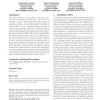645 search results - page 36 / 129 » Structured Hidden Markov Model: A General Framework for Mode... |
CIARP
2009
Springer
14 years 2 months ago
2009
Springer
Many tasks can be described by sequences of actions that normally exhibit some form of structure and that can be represented by a grammar. This paper introduces FOSeq, an algorithm...
WABI
2010
Springer
13 years 6 months ago
2010
Springer
Abstract. Applied Biosystems’ SOLiD system offers a low-cost alternative to the traditional Sanger method of DNA sequencing. We introduce two main algorithms of mapping SOLiD’...
CVPR
2007
IEEE
14 years 9 months ago
2007
IEEE
We introduce novel discriminative learning algorithms for dynamical systems. Models such as Conditional Random Fields or Maximum Entropy Markov Models outperform the generative Hi...
KDD
2008
ACM
14 years 8 months ago
2008
ACM
This paper presents a new algorithm for sequence prediction over long categorical event streams. The input to the algorithm is a set of target event types whose occurrences we wis...
ATAL
2007
Springer
14 years 1 months ago
2007
Springer
Activity recognition is a key component for creating intelligent, multi-agent systems. Intrinsically, activity recognition is a temporal classification problem. In this paper, we...

